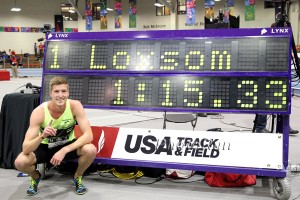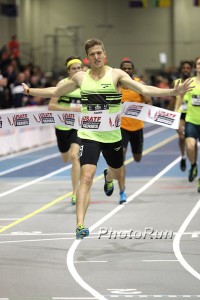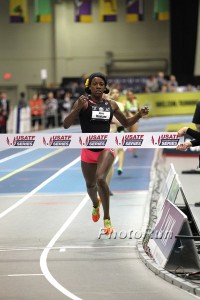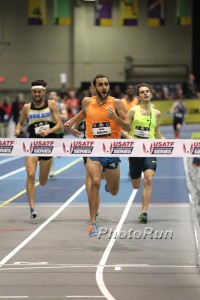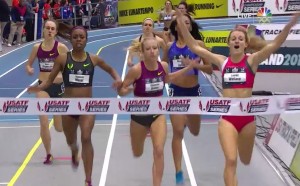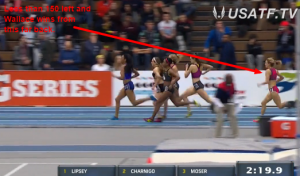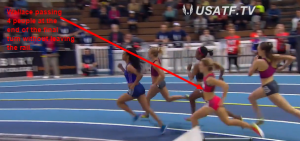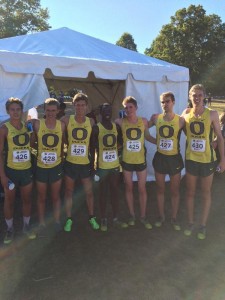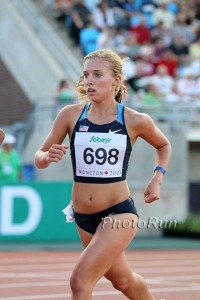Hyping Montaño, Rowbury And Andrews; Tapping The Brakes On Loxsom’s AR; Plus A Collegiate Record For Emily Sisson And The Oregon Ducks Are Insanely Good
by LetsRun.com
March 4, 2015
Previous versions of The Week That Was – our weekly recap – can be found here. The US Indoor Champs was the biggest meet of the week and our complete coverage of that is here.
Below we go into more depth on USAs and cover everything else, including some crazy good collegiate action and a new collegiate record at 5,000m by Emily Sisson.
****
Just What Is Cas Loxsom’s 1:15.33 600 Worth?
One of the highlights of 2015 USA indoors was Cas Loxsom’s 600 American record of 1:15.33. We decided to ask, “What is that worth?”
Taken literally, his 600 win at USA Indoors was worth $5,000 in prize money + contract bonuses for winning a national title and setting an American record. So we’re into the five figures. We’re more interested in what the time is worth as a performance.
Let’s begin by saying it’s obviously a very impressive race. Loxsom dominated the USA final, it wast just .21 off of the world record, and no American has ever run faster indoors.
If the indoor American record is 1:15.33, the outdoor American record shouldn’t be that far off, right? 1:14, maybe 1:13?
Try 1:12.81 (Johnny Gray in 1986; that time is also the world record). Suddenly, 1:15.33 doesn’t seem so fast. So is the current 600 AR indoors weak? Or are there other factors in play that explain the difference?
To find out, we compared the men’s American indoor and outdoor records at every track distance from 200 to 5,000 meters (since the 600 is rarely run, we also included less common distances such as 300 and 1,000 meters).
| Distance | Outdoor AR | Indoor AR | % difference |
| 200 | 19.32 | 20.10 | 4.0 |
| 300 | 30.85 | 31.88 | 3.3 |
| 400 | 43.18 | 44.57 | 3.2 |
| 600 | 1:12.81 | 1:15.33 | 3.5 |
| 800 | 1:42.60 | 1:45.00 | 2.3 |
| 1,000 | 2:13.9h | 2:16.76 | 2.1 |
| 1,500 | 3:29.77 | 3:33.34 | 1.7 |
| Mile | 3:46.91 | 3:49.89 | 1.3 |
| 3,000 | 7:29.00 | 7:30.16 | 0.3 |
| 2-Mile | 8:07.07 | 8:07.41 | 0.07 |
| 5,000 | 12:53.60 | 13:01.26 | 1.0 |
The data is interesting, though perhaps not a huge surprise to educated track fans. In general, the shorter the distance, the further apart the records are. In an outdoor 200, there is only one turn and it’s far more gentle than any turn on an indoor track. In an indoor 200, there are two and they are both sharp compared to an outdoor track. As the distance goes up, the tightness of the turns becomes less important and the records become closer together. Looking at Loxsom’s mark in particular, it is a minor outlier, which suggests that his AR could come down even further in the years to come. Considering that the record has been broken four times in the past three years, it seems likely that it will keep creeping closer to 1:15.00 should guys like Loxsom, Erik Sowinski and Duane Solomon continue to contest the distance indoors.
Outdoors, Loxsom himself has run 1:14.84 – in the same race that Duane Solomon ran 1:13.28 two years ago (#2 all-time).
Loxsom realizes the top guys in the world are not going to be scared by a 1:15.33 600 indoors. “I mean, shoot, the Olympic final is going to be going out about as fast as I ran there so it’s fast, but it’s not anything out of control,” Loxsom said.
Indeed, in the 2012 Olympic final, David Rudisha went out in 1:14.30 for 600 meters, over a second faster than what Loxsom ran for a full 600 on Sunday. That Olympic final was particularly fast, though (you may remember it; David Rudisha set the world record of 1:40.91 in an all-time classic race), as none of the three global championships that preceded it went out in faster than 1:16.73.
Rather than try to quantify Loxsom’s American record with a nearly 500-word explanation plus a chart as we did above, perhaps it would have been easier and quicker to just ask John Kellogg, LetsRun.com’s resident coaching/stat guru.
JK says a 1:15.33 600 is equivalent to 1:46.14 for 800. 1:46.14 may not sound fast but it would put Loxsom #9 all-time in the US, just ahead of 1997 World Championship bronze medalist Rich Kenah (1:46.16 indoor PR) as only five Americans have broken 1:46.00 indoors.
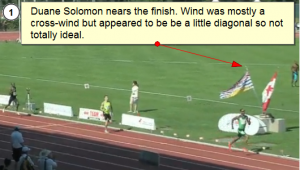 This Is What A 1:13:28 Looks Like. *Race Recap
This Is What A 1:13:28 Looks Like. *Race Recap
(If you doubt JK’s conversion, you shouldn’t. We explained why in 2013 here. His conversion puts Solomon’s 1:13.28 at 1:43.27 for 800).
In the end, it’s very difficult to say what impact – if any – Loxsom’s AR will have on his outdoor season. In 2013, Solomon ran 1:15.70 indoors and wound up sixth at Worlds in the 800 outdoors; Sowinski ran .09 faster indoors but was just sixth at USAs in the 800 outdoors. Loxsom’s 2015 season will likely end up somewhere between those two outcomes.
More important to Loxsom than setting the American record was becoming the national champion. Second at World Juniors, second at NCAAs, second at USA outdoors. National champion has a nice ring to it.
More: LRC Archives from 2013: Duane Solomon Runs Second-Fastest 600 Race Ever – 1:13.28 – at Harry Jerome Classic
*Cas Loxsom The Bridesmaid No More, He Breaks American 600m Record To Win His First USA Title
****
What About The Other Winners At USAs? What Can We Take Away?
What about the other wins in the mid-d and distance action USAs?
Here’s what we think it all means:
Matthew Centrowitz‘s win in the 1,500 didn’t tell us anything we didn’t already know – he’s one of the best milers in the world.
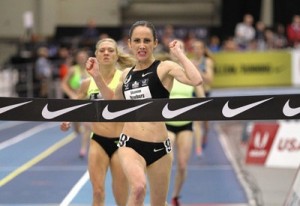 Shannon Rowbury‘s wins in the mile and 2-mile were expected and showed us she should be in the hunt for a medal at 1,500, particularly since it seems unlikely that there is any threat of there being a bunch of doped-up Russian or Turkish athletes coming out of the woodwork to prevent her from getting a medal. Think back to the 2012 Olympics. If drug testing was 100% foolproof, Rowbury might be an Olympic medalist. Rowbury was 6th in 2012, but two of the women who beat her have been accused or convicted of doping and third came out of nowhere and disappeared thereafter:
Shannon Rowbury‘s wins in the mile and 2-mile were expected and showed us she should be in the hunt for a medal at 1,500, particularly since it seems unlikely that there is any threat of there being a bunch of doped-up Russian or Turkish athletes coming out of the woodwork to prevent her from getting a medal. Think back to the 2012 Olympics. If drug testing was 100% foolproof, Rowbury might be an Olympic medalist. Rowbury was 6th in 2012, but two of the women who beat her have been accused or convicted of doping and third came out of nowhere and disappeared thereafter:
2012 Olympic 1,500 Top 6
1. Aslı Çakır Alptekin – Turkey – suspected doper. Case is still under appeal.
2. Gamze Bulut – Turkey – no links to doping but ran 4:18 in 2011, won Olympic silver in 2012, ran 4:07 in 2014. That’s unusual to say the least.
3. Maryam Yusuf Jamal – Bahrain – very credentialed star
4. Tatyana Tomashova – Russia – 4:10.90 – convicted of doping in 2008
5. Abeba Aregawi – Ethiopia – 4:11.03 – superstar
6. Shannon Rowbury – United States
With Ajee Wilson‘s fall, Alysia Montaño‘s win was far from a surprise. Given the fact that she gave birth in August, we would have been very surprised if you told us at the start of indoors, she’d be the U.S. champion. The win shows her career is far from over and she should be in the medal hunt this summer.
Speaking of medals, we forgot to ask Montaño if she has thought about the fact she could be upgraded to an Olympic bronze medal from 2012.
What are we talking about?
Take a look at the 2012 women’s 800 results. It could be argued that all of the women who beat Alysia had a physical or chemical advantage over her.
1. Mariya Savinova – Russia – mentioned in German TV report on doping.
2. Caster Semenya – South Africa – intersex condition has been much talked about.
3. Ekaterina Poistogova – Russia – mentioned in German TV report on doping
4. Pamela Jelimo – potential intersex issue hasn’t been talked about publicly very much but has been behind the scenes as shown here and here.
5. Alysia Johnson Montaño – United States
If Savinova and Poistogova are removed from the results for doping, Semenya will be upgraded to gold, Jelimo to silver, and Alysia will get the bronze.
Speaking of Alysia and Ajee, check out this nice video Alysia did with Ajee. Nothing like a friendly rivalry between two of America’s stars.
Robby Andrews‘ win in the men’s 1,000 was just what he needed. Yes, the field was far from loaded but after struggling in 2013 and 2014, Andrews enjoyed a perfect “Get your confidence back” indoor campaign which basically featured two 1ks – a narrow loss to Erik Sowinski at Millrose and the win at USAs.
Andrews is still just 23. That’s the same age as Leo Manzano when Leo graduated from Texas in 2008. Had Andrews kept competing at UVA instead of going pro early, he might be viewed differently than he is now. Andrews ran 3:34.78 while in college (but not competing for UVA) as a 21-year-old in 2012.
That’s very fast for an American-born athlete.
Fastest 1500s Ever Run By An American While A College Student
1) Jim Ryun – 3:33.1 at age 20 in 1967.
2) Matthew Centrowitz – 3:34.46 at age 21 in 2011.
3) Robby Andrews – 3:34.78 at age 21 in 2012.
Related: MB: Kyle Merber 3:35.59 is NOT the American Collegiate Record
Lauren Wallace had the only shock win of the weekend. The 2013 UC Davis product, who only made NCAAs once in college (eighth as a senior outdoors), got the win in the 1000 despite having the modest PRs of 2:02/4:18/4:38 for 800, 1,500 and 3,000.
How did she do it?
By running a tactically brilliant race and staying on the inside as everyone else ran way more than 1,000 meters.
Wallace led the first three laps. Once she lost the lead, she stayed on the rail. She passed everyone on the rail coming home as well. She ran closer to 1,000 meters than anyone else in the field. Compare her to Treniere Moser. Moser didn’t like being boxed in early so she went way wide into lane 2 from 500 to 700. She then was also near lane two from 700 to 750 and 800 to 950 before finishing the race in lane 3. All together, we’d say she ran at least the equivalent of three turns in lane 2. Each lap in lane 2 is an extra 22 meters feet indoors. So Moser ran 1,033 meters an extra 33 feet as compared to Wallace’s 1,000 meters.
What does it mean? Well, Moser’s runner-up time was 2:40.62. Wallace won in 2:40.42. But if you assume Moser ran 1,033 meters 33 extra feet, it means should would have hit 1k in 2:35.89 2:39.02, crushing Wallace.
Yes, we know Wallace didn’t run exactly 1,000 meters. But watch the tape, there is no way one can say Moser didn’t run at least a full lap more in lane 2 than Wallace. Even if Moser ran just 20 meters feet more than Wallace, 20 meters feet at that pace takes more than two full seconds to run almost a full second to run (.98).
.20 of a second was the margin of victory. Every extra 1.3 meters 4.1 feet = .20 of a second.
(Editor’s note: Sorry about the mistake. We had a brain freeze and misread the stagger chart, which was presented in terms of feet, not meters)
****
Free Coaching Advice: Race Leaders, Don’t Ever, Ever Leave Lane 1. EOM.
Having watched Wallace steal a race by coming up the rail (and also having seen the men’s mile won at the Ivy League Championships in Boston with a similar on-the-rail move), we are forced to give out this free coaching advice.
Distance runners, don’t ever, ever leave lane one in the homestretch if you are in the lead unless you are lapping someone. Don’t do it. Yes, we know you want to go wide when you are hanging on for dear life to make the guy or girl behind you run even further. But going out into lane 2 or 3 doesn’t make them run any farther as compared to you than staying in the outside of lane 1 does. No matter what you do, the person behind you is going to finish a half lane wider than you. If you drift all the way to lane 4, they will finish just outside of you in lane 4.5 – they’ll just run a half lane wider. If you finish in lane 1, they finish in 1.5. But if you leave lane 1, the people in third or fourth or fifth can stay on the rail.
In Wallace’s race, Charlene Lipsey left lane 1 and the rest is history.
****
The MPSF Men’s 3,000 Was The Deepest Race Of The Weekend (In The U.S.)
Sunday was the final day for athletes to grab a qualifying time for the 2015 NCAA Division I Indoor Track & Field Championships (to be held at the University of Arkansas on March 13-14) and as a result, there were a slew of incredibly fast times. In terms of depth, the best distance race of the weekend by far was the 3,000 at the Mountain Pacific Sports Federation Championships (PAC-12 schools plus several other western powers such as Portland and BYU) in Seattle, where a ridiculous 14 men broke 8:00, with 9 under 7:55 (Oregon’s Jeremy Elkaim got the win in 7:48.48). Colorado alone had five guys under 8:00 in the same race, which may be even more impressive than Georgetown’s feat of putting four guys under 4:00 in the mile at the Valentine Invitational in Boston.
The top 16 declared men on the NCAA performance list get a bid to indoor NCAAs; five of the top 16 marks in the 3,000 came from the MPSF Championships. With an additional five of the top 16 coming from the UW Husky Classic, it’s clear Washington’s Dempsey Indoor facility remains the best place in the country to qualify for NCAAs in the long-distance events, but a lot of that likely has more to do with the quality of the distance events at schools in the Western U.S. than anything else. Case in point: The fastest times in the U.S. at 3,000m were run by Oregon’s Eric Jenkins and Will Geoghegan when they went 1-2 at the Millrose Games in New York City.
Overall, the quality of depth in the NCAA is much better than it was even five years ago. Check out the #16 times on the NCAA list in 2010 compared to this year:
| Event | 2010 | 2015 |
| 800 | 1:48.60 | 1:48.19 |
| Mile | 3:59.17 | 3:58.25 |
| 3,000 | 7:57.42 | 7:53.27 |
| 5,000 | 13:53.61 | 13:47.22 |
How good is the NCAA? Even if you threw out the top 16 guys on the NCAA list this year, you’d still have to go under 4:00 in the mile to make NCAAs; UVA’s Mike Marsella is currently #32 on the NCAA list at 3:59.97. The depth in the 3,000 is similarly scary as the #32 time is 7:56.36 by Craig Nowak of Oklahoma State.
It’s Almost Unfair How Loaded Oregon’s Distance Crew Is
If the Men of Oregon are to repeat as indoor NCAA champions, they will once again do it on the strength of their distance squad. The NCAA declarations will differ slightly from the current descending order lists, but if we take the top eight in the mile, 3,000, 5,000 and DMR and score them based purely on seed time, here’s how the scoring comes out for the top five schools:
Oregon 63
Virginia Tech 15
Penn St. 12
Arkansas 12
Montana St 10
Oregon’s winning point total last year – across all events – was 62 (Arkansas was second with 54). Here are the SBs of their projected scorers, with NCAA rank in parentheses:
Edward Cheserek, sophomore
SBs: 3:56.43 mile (#2); 7:49.56 3,000 (#6)
Eric Jenkins, senior
SBs: 7:44.91 3,000 (#1); 13:31.76 5,000 (#1)
Will Geoghegan, senior
SBs: 3:58.36 mile (#17); 7:45.71 3,000 (#2); 13:43.22 5,000 (#10)
Parker Stinson, senior
SBs: 7:52.21 3,000 (#13); 13:38.68 5,000 (#3)
Jeramy Elkaim, junior
SBs: 7:48.48 (#4)
Johnny Gregorek, senior
SBs: 3:57.47 mile (#7); 7:54.85 3,000 (#25)
Daniel Winn, senior
SBs: 3:57.82 mile (#8)
Jeramy Elkaim won the incredibly fast MPSF meet this past weekend and is #4 on the NCAA list but he may only be Oregon’s fourth-best 3,000m runner.
A few other notes on Oregon:
- Edward Cheserek will not defend his 5,000m crown indoors. He didn’t put up a qualifying time, posting marks in the mile and 3,000 instead. Expect him to run the mile, 3,000 and DMR at NCAAs.
- Oregon could have almost a third of the competitors in the men’s 3,000. The Ducks have five of the top 13 guys on the NCAA list (including four of the top six) and two more in the top 25 (#19 Jake Leingang at 7:53.82 and Gregorek at #25).
- With the two fastest guys this year (by some margin) in Jenkins and Geoghegan and the defending champion in Cheserek, Oregon has a realistic shot at going 1-2-3 in the 3,000. No teammates have gone 1-2-3 in any event at indoor NCAAs in the past 10 years (though Oregon’s Andy Wheating, A.J. Acosta and Matthew Centrowitz went 1-2-3 in the 1,500 outdoors in 2010). Only three sets of teammates have even gone 1-2 an event at indoor NCAAs in the past 10 years; the names of many of those athletes should be familiar to anyone who follows the sport (athletes in bold own an Olympic medal):
| Year | Event | Winner | Runner-up | School |
| 2011 | Triple jump | Will Claye | Christian Taylor | Florida |
| 2008 | 60m | Richard Thompson | Trindon Holliday | LSU |
| 2008 | Mile | Leo Manzano | Jake Morse | Texas |
Oregon, of course, also went 1-2 in cross-country last fall with Cheserek and Jenkins.
Andy Powell is doing a phenomenal job with his team this indoor season. He’s doing such a good job, it just makes us wonder how were they only sixth as a team in XC last fall?
If you want more NCAA talk go here: Observations On The Men’s NCAA Indoors Entries: Oregon Vs. Florida In Team Race + What Does It Take To Get In?
****
Collegiate 800 News Of Note
Marla Runyan, move over. There may be another former multi-eventer who turns out to be a mid-d star.
At the SEC Championships last week, Ole Miss redshirt frosh Brooke Feldmeier, who was the 2012 and 2013 Washington state heptathlon champion, was the runner-up in a stellar 2:04.34 – a great time for a frosh (it’s #1 for freshmen in the NCAA), and a huge improvement over the 2:17.86 she ran in HS. Feldmeier is listed a multi-eventer on her Ole Miss bio page but it’s clear to us and the coaching staff that her future lies in mid-distance. On the year, she’s done a grand total of zero field events, one open 400, one open 600 and six 800s.
In high school, she achieved the following marks: 200 (24.80), 400 (54.37), 100 hurdles (14.43), 300 hurdles (45.25), high jump (5-5) and heptathlon (4,917).
Next up for Feldmeier, the NCAA champs. Her 2:04.34 makes her the ninth-fastest in the NCAA this year.
More: *Good High School Profile Of Brooke Feldmeier *Ole Miss Bio
****
Last week, we failed to give out props to Monmouth sophomore Dylan Capwell. At the MAAC Championships at the Armory, he ran 1:46.82 – which is the #4 time in the NCAA this year and the #1 time ignoring oversized tracks. That performance caught the eye of regular WTW reader David Monti, who emailed us the following:
“That’s the fastest time ever by a collegian at The Armory, run in a championships race with no pacemaking. Where did that come from?”
That’s a good question. Monmouth may not be known as a distance powerhouse, but Capwell was a stud in high school at Hopatcong in New Jersey. He was NJ Meet of Champs winner in the 400H and third-placer in the 800. He had PRs of 48.62 for 400, 52.43 for 400h and 1:50.85 for 800. He’s now thriving at Monmouth under mid-d coach Chris Tarello, who also coached Ford Palmer. As a frosh, Capwell ran 1:47 and made NCAAs outdoors where we interviewed him:
We’ll have much more on the NCAA qualifiers when the entries come out later this week.
MB: Sophomore Dylan Capwell runs 1:46 solo to break NYC Armory collegiate record
****
Emily Sisson Breaks Collegiate 5,000m Record
The collegiate performance of the weekend last week belonged to Providence senior Emily Sisson. Sisson, who didn’t run XC last fall as she was out of eligibility, broke fellow Friar Kim Smith‘s 15:14.18 collegiate record by running 15:12.22 at the Big East championships in a race where second place was 16:20.86. Kudos to Sisson and Providence coach Ray Treacy, who also coached Smith.
Sisson is now the seventh-fastest performer ever, indoors or out. The fastest time ever belongs to Jenny Simpson and it came indoors but on an oversized track.
The question now becomes, “Can Sisson become the first collegian to break 15:00 outdoors?”
The Fasted 5,000 Runners In NCAA History (Indoors Or Out According To T&FN)
1. 15:01.70i Jenny Simpson (Colorado) 02/14/09
2. 15:09.72 Kim Smith’ (Providence) 04/16/04
3. 15:11.13 Aisling Cuffe (Stanford) 05/04/14
4. 15:11.35 Abbey D’Agostino (Dartmouth) 04/19/13
5. 15:11.88 Sally Kipyego (Texas Tech) 04/18/08
6. 15:12.05 Betsy Saina (Iowa St) 03/29/13
7. 15:12.22i Emily Sisson (Providence) 03/03/2015
Also this week the news came out that NCAA cross-country champion Kate Avery of Iona isn’t going to run NCAA indoors next weekend (this week Avery is racing Europeans)
More: MB: Emily Sisson 15:12
*MB: NCAA XC Champ Kate Avery Won’t Run NCAA Indoors; Doing European Indoor Champs Instead
****
Upset Of The Week:
North Texas’ Troy Taylor, a junior who has an 8:19.30 3k PR, beat reigning NCAA indoor mile champ Anthony Rotich, who has a 3k PR of 7:53.43, in the men’s 3,000 at Conference USA. Taylor does have a 3:44 1,500 PR but Rotich has plenty of speed himself.
Do you know of other big upsets? Post them here: Looking for biggest upsets from NCAA conferences. Both team and individual. 8:19 Troy Taylor took down 7:53 A. Rotich.
****
Vivian Cheruiyot Returns To Action At The Richest 10k In America – The World’s Best 10k
The richest 10,000m in America took place this past weekend in Puerto Rico at the World’s Best 10k that has $120,000 in prize money. Sammy Kitwara of Kenya and Belaynesh Oljira of Ethiopia were your winners with Kitwara winning for a record fifth time. Perhaps just as important was Vivian Cheruiyot, the four-time world champion, returning to international action for the first time since she had a child in October 2013 (she made her overall return with some XC races in Kenya). She was eighth, 1:26 behind the winner. Ben True ran and was sixth on the men’s side. Steepler Donn Cabral was just three seconds back of True in eighth, ahead of Yenew Alamirew.
*Top Results
*MB: Donn Cabral takes down Yenew Alamirew
*MB: Ben True takes down Donn Cabral
****
The Real Deepest Race Of The Weekend – Japan Shows Its Amazing Depth (Again)
Correction – above we should have said the MPSF 3,000 was the deepest track race of the weekend. In Japan, the amazing Japanese depth showed up once again. In January, we were very impressed that 48 American men broke 65:00 in Houston to qualify for the Olympic Marathon Trials.
Guess how many men did that in Japan last weekend at the Tachikawa Akishima Half Marathon (18th National University Half Marathon Championships)?
Japan Running News’ Brett Larner has done the legwork for us.
The number is staggering.
It’s 159 – all of them Japanese and 157 of them collegians.
(265 men broken 1:06 in the race which was won by 20-year-old Tadashi Isshiki in 62:11).
For the year, Larner believes “at least 330 Japanese men” have already broken 65:00 for 13.1 in just two months.
That’s pretty amazing as 65:00 equates to 29:22 for 10,000 meters according to John Kellogg’s conversion chart.
Last year in the US, 67 men collegiate ran 29:22 or faster (61 DI, 5 DII, 1 DIII) and many of them were foreigners. Including professionals, 74 American men ran 29:22 or faster last year, according to All-Athletics.com.
(Yes, not all Americans run the 10,000. But even looking at the 5,000 equivalent of 14:01, only 87 collegians in America (81 DI, 5 DII, 1 DIII) ran that fast in 2015.
More: Japan Running News Hakone Champion AGU’s Isshiki Leads 27 Under 1:03 And 265 Sub-1:06 At National University Half Marathon Championships
*Complete University Results
*Top General Results
****
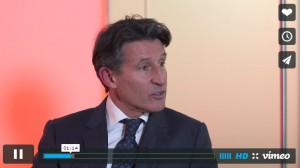 Seb Coe Makes His Case For IAAF Presidency On LetsRun.com
Seb Coe Makes His Case For IAAF Presidency On LetsRun.com
Last week, IAAF Vice-President and Olympic legend Seb Coe made his case for the IAAF Presidency in a series of videos released exclusively on LetsRun.com. If you missed the series, click here.
****
5 Quotes Of The Week (That Weren’t Quote Of The Day)
I
“I have almost every social media outlet. Twitter is the best for me to interact with the fans and I do that. … I’m a social person and like to respond to everyone and everything. Whenever people accuse me or my team of doing drugs, I always respond with some kind of smart-ass comment, which my agent doesn’t like. I think it’s a great way to interact and engage and it’s the only way some of our fans can engage if they can’t go to a meet.”
– Matt Centrowitz talking at the USA Indoor Championship pre-meet press conference about how he uses social media.
###
II
“Six weeks ago I was thinking that to run in the 2:15 range would be on that course really phenomenal. Right now I feel like 2:13 is definitely possible. … I’m getting very excited, particularly on the strength side of things, the workouts have been very very good. Yeah, I’m starting to get some big eyes.”
– 2:14 marathoner Nate Jenkins (seventh at the 2007 Olympic Trials) talking in a cloud259.com podcast interview about making his comeback from seven years of injury at the Boston Marathon.
*Some Good Insights Into Jenkins’ Comeback/Training In His Blog *MB: Nate Jenkins returns to Marathon
###
III
“But this still is a national championship. It’s taking place before March Madness, before the baseball season, before the hockey playoffs, during the dog days of the NBA season. Nothing so decisively drives home the sport’s lack of national relevance like the near invisibility of a national championship in what should be a dead period on the sports calendar.”
###
IV
“I could not wait for this environment to do something when I am not holding an eight-pound baby in the process.”
– Alysia Montano talking after day 1 of USA Indoors.
###
V
“I left my watch in the [changing] room so I asked my friend to hand over his watch when he is done with the pacing duties.”
– Kenya’s Samuel Ndungu, who ran 2:09:08 to win the Lake Biwa Marathon, talking about how he forgot his watch and asked for one of the pacemakers to give him his before he dropped out. It was about all the pacers were good for as they were all over the place with the pace, and even almost took the field off course.
****
Quotes Of The Day And Last Week’s Home Pages
To see the actual quotes of the day from last week or last week’s home page or any home page, go to our archive page.
Questions, comments, please email us or post them in our running fan forum.
That is it, if you were gone over the weekend. We had extensive coverage and analysis of the 2015 USATF Indoors Champs when they took place: Full 2015 USATF Indoor coverage.
- Professional
- College
- Week That Was
- LRC
- Women's Running
- Men's Running
- Distance
- Mid-Distance
- Column
- Edward Cheserek
- Vivian Cheruiyot
- Shannon Rowbury
- Ben True
- Robby Andrews
- Cas Loxsom
- Matt Centrowitz
- Eric Jenkins
- Will Geoghegan
- Alysia Montano
- Parker Stinson
- Marla Runyan
- Andy Powell
- Jeramy Elkaim
- Johnny Gregorek
- Lauren Wallace
- Dylan Capwell
- Brooke Feldmeier
